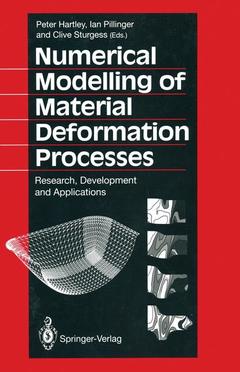Numerical Modelling of Material Deformation Processes, Softcover reprint of the original 1st ed. 1992 Research, Development and Applications
Langue : Anglais
Coordonnateurs : Hartley Peter, Pillinger Ian, Sturgess Clive E.N.

The principal aim of this text is to encourage the development and application of numerical modelling techniques as an aid to achieving greater efficiency and optimization of metal-forming processes. The contents of this book have therefore been carefully planned to provide both an introduction to the fundamental theory of material deformation simulation, and also a comprehensive survey of the "state-of-the-art" of deformation modelling techniques and their application to specific and industrially relevant processes. To this end, leading international figures in the field of material deformation research have been invited to contribute chapters on subjects on which they are acknowledged experts. The information in this book has been arranged in four parts: Part I deals with plasticity theory, Part II with various numerical modelling techniques, Part III with specific process applications and material phenomena and Part IV with integrated computer systems. The objective of Part I is to establish the underlying theory of material deformation on which the following chapters can build. It begins with a chapter which reviews the basic theories of classical plasticity and describes their analytical representations. The second chapter moves on to look at the theory of deforming materials and shows how these expressions may be used in numerical techniques. The last two chapters of Part I provide a review of isotropic plasticity and anisotropic plasticity.
I. Introduction to Plasticity Theory.- 1 Classical Plasticity.- 2 Finite Deformation of Solids.- 3 Isotropic Plasticity.- 4 Anisotropic Plasticity.- II. Review of Numerical Techniques in Material Deformation Processes.- 5 The Upper Bound Method.- 6 Boundary-Element Analysis of Forming Processes.- 7 The Rigid-Plastic Finite-Element Method for Simulation of Deformation Processing.- 8 The Viscoplastic Approach for the Finite-Element Modelling of Metal-Forming Processes.- 9 The Elastic-Plastic Finite-Element Method.- III. Specialized Applications and Topics.- 10 Numerical Modelling of Forging.- 11 Rolling Process Modelling.- 12 Extrusion and Drawing.- 13 Numerical Modelling of Sheet Metal-Forming Problems.- 14 Forming of Metal Matrix Composites.- 15 Finite-Element Analysis of the Superplastic Forming of Thin Sheet Components.- 16 Fracture in Forming Processes.- IV. Computer Integrated Systems.- 17 Integration of Numerical Modelling and CAD/CAM Systems.- 18 Application of Knowledge-Based Techniques.
Date de parution : 01-2012
Ouvrage de 460 p.
17x24.2 cm
Thème de Numerical Modelling of Material Deformation Processes :
© 2024 LAVOISIER S.A.S.



